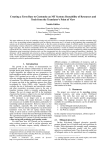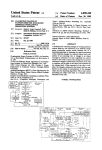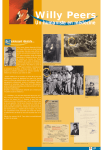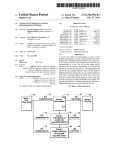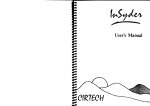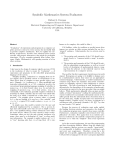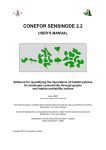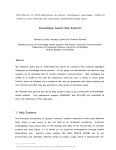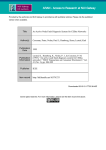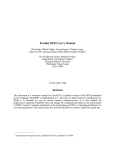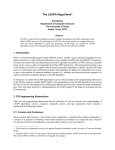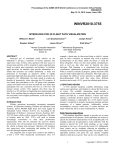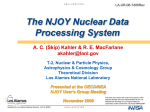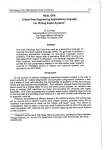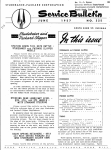Download 1986 - Advances in Rete Pattern Matching
Transcript
From: AAAI-86 Proceedings. Copyright ©1986, AAAI (www.aaai.org). All rights reserved. ADVANCES IN RETE Marshall Timothy 1. Schor, P.O. P. Daly, A central algorithm in production systems is the pattern match among rule predicates and current data. Systems like OPS5 and its various derivatives use the RETE algorithm for this function. This paper describes and analyses several augmentations of the basic RETE algorithm that are incorporated into an experimental production system, YES/OPS, which achieve significant improvement in efficiency and rule clarity. Introduction Rule based systems often spend a large fraction of their execution time matching rule patterns with data. The production system OPS5 [FOR11 and many other systems (e.g. [ART11 [YAP11 [FOR3]), each use the OPS5 pattern match algorithm known as RETE. This paper describes four augmentations of the basic RETE algorithm that achieve much improved performance and rule clarity. As we describe each augmentation, we give an analysis of its effects, and some examples of its use. These ideas are implemented in an experimental production system language, YES/OPS, running on LISP/VM in IBM Yorktown Research. We presume some familiarity with production systems, and the RETE algorithm. The reader is referred to the book, Programming Expert Systems in OPSS [BROl], and the AI Journal article on the RETE algorithm [FOR21 for background information. The first augmentation involves handling changes to existing data. In OPS5, three operations affect the data being matched with the rule make, which adds new data, remove, which removes data patterns: previously added, and modify, which modifies data previously added. However, modlf y is implemented in OPS5 as a remove of the previously existent data, followed by the creation of new data that is a copy of the previous data, except for the attributes that were changed. This new data is then added, which causes a new match cycle to occur. We change this to support modify as an update-inplace operation, and change how the rules are (re-)triggered, for greater clarity. The second augmentation allows the user to group rule patterns (called condition elements) together, in an arbitrary fashion. This enables specifying negated joins of patterns, not just individual condition elements, and plays an important role in specifying when to do maximize and minimize operations (which follows). The grouping can also be used to increase pattern match result sharing among the rules, for efficiency. The third augmentation supports the specification of sorted orderings among sets of data, in a much more efficient and syntactically clear manner. The final augmentation is the ability to do the pattern matching on demand, incrementally. This supports both the incremental addition of new rules, such that the new rule does match the existing data (not possible in OPS5), and the matching of particular patterns as part of an action done w-hen a rule fires, not when the data changes. This aspect eliminates the (OPS5) requirement that data to be manipulated in the action part of a rule must be matched by a condition element pattern in the rule’s tests (its Left Hand Side). This allows many practical rule sets to achieve orders of magnitude performance im- / SCIENCE MATCHING Ho Soo Lee, Beth R. Tibbitts IBM T. J. Watson Research Center Box 218, Yorktown Heights, NY 10598 Abstract 226 PATTERN USA provement, by reducing the pattern matching part of the rules to just that part which needs to be data-change sensitive. All examples of rules are written using the YES/OPS syntax. This is similar to OPS5 syntax, except: 1) attributes are not preceded by an “f” character, but are followed instead by a colon “:‘I; 2) the rule form is: (P rule-name WHEN pattern matching specifications THEN actions to be done) MODIFY as update-in-place, new triggering conditions OPS5’s implementation of modify as a remove of the old value, and a re-make of it with the modified attributes causes excessive retriggering of rules. Two commonly occurring instances of unwanted re-triggering are modification of attributes not tested in a rule and modification of an attribute to a value that still passes the same rule patterns as before. Example: Don’t-care slots re-triggering Suppose the user structures his working memory elements for a problem involving genealogy research, as follows: Classname: Attributes: PERSON Name : Father: Mother: Gender: Native-language: Native-country: Marital-status: Spouse Language: Now suppose some rules infer about ancestry, and other rules infer about languages spoken. If the ancestry rules have fired, and now, some new information about language causes the person’s language : attribute to be changed, in OPS5, the ancestry rules would fire again, even though they had taken all the actions appropriate for their matches to the existing data, and that data had not changed in the attributes of interest. The solution to this behavior in OPS5 is to separate attributes whose change should not re-trigger other rules, into different working memory elements. This is often not the natural partition of the knowledge, and is less efficient, because the RETE must now do run-time joins of the split-apart attributes. Example: Tests true once, true again after modifying, re-triggering In OPS5, whenever a rule’s action part modifies a working memory element such that it still satisfies the rule’s tests, that rule loops. Users are told to “get around” this problem by coding extra control information in the working memory element and set flags that prevent looping. An example from the book Programming Expert Systems in OPS5 [BROl] is the problem of adding one to a set of items. The natural formulation (the one inexperienced users tend to write) looks like : (p add-l-to-items when (goal name: add-l-to-items) ;the goal to do it <i> (item value: <v>) whose value is <v> ;an item, then ;modify the item (modify <i> value: (<v> + 1) >) ;setting the value ; to <v’ + 1 : This works in YES/OPS, when modify is update-in-place, but loops in OPS5. The suggested rule formulation to get around this problem in OPS5 is to add an extra attribute to Item, called status, and set it from nil to marked when doing the adding. After adding to all the items, the goal is advanced to unmark, and another rule fires repeatedly, once per item, to change the status attribute back to nil. This clearly is more rule firings, and also, more testing (the value of the status attribute must be tested). The example also is now cluttered up with control information, unrelated to the task of adding 1 to a set of items, which makes these OPSS-style rules less readable: (p add-l-to-items when (goal name: add-l-to-items) ;the <i> (item then (modify value: <i> <v> value: status: status: goal to do it nil) (compute <v> ;this ;prev. ;tests add-l-to-items) rule fires after rule because it fewer things <g> (goal name: then (modify <g> name: UNMARK)) -----______---------------------------------(p unmark when (goal <i> (item then (modify name: status: <i> change value: <v>> 1))) Tokens passed down the RETE have the operation ADD, REMOVE, or MODIFY associated with them (ADD corresponds to make). For modify operations, if at some point in the processing, the test result of the previous value of the modified working memory element differs from that of the current value, the modify operation is converted to a remove or add operation: CASE 1 tests fail tests OK ADD CASE 2 tests OK tests fail REMOVE When a token arrives at the bottom of the RETE, if the operation is add or remove, then the rule instantiation in the production node is either inserted to or removed from the conflict set, according to the operation; if the operation is modify, then nothing is done. This prevents re-triggering. For modify operations, specification of re-triggering attributes causes an exception. If one or more of the attributes was preceded by an “!” to indicate that re-triggering is wanted on any change of that attribute, the attributes so designated are compared with those that were modified; if one or more match, then the rule is reinserted into the conflict set even if it has already fired. UNMARK) MARKED) status: on New algorithm for Modify in RETE Beta Join nod&s Previous value: Current value: New operation: + 1) MARKED)) ----------________--------------------------(p change-task when (p count-marital-status-changes when (person ! marital-stat:) *I retriggers cc> (counter type: Marital-stat-chg then (modify cc> value: (<v> + NIL)) Having to code this kind of status information makes the rules less clear. Without implementing the new modify definition, the natural rule an expert often writes would need to be “fixed” to eliminate the unwanted triggering. The efficiency also suffers, in that the fixes require more pattern matching tests. New modify definition remom re-tri&gering problems We define modify as an atomic update-in-place operation, rather than as a remove followed by a make of the modified working memory element. The triggering rules are changed so that an existing instantiation that continues to exist after the modify, does NOT cause re-triggering. Join nodes where left and right predecessors are identical Special case handling is required where the left and right inputs to a join node are identical. This arises in rules like: (p find-skilled-persons when (person name: <s> (person name: <n> then (say <s> can help skill: <sl>) needs-skilled-service: <n> with service <sl>) <sl>)) This yields the RETE structure: In addition to improving performance by eliminating extra control flags and their testing and maintenance, modify done as update-inplace reuses existing working memory data structure and RETE memory nodes. This improves the performance by reducing the activity involved with maintaining these structures. Triggering on any change The new modify semantics normally trigger a rule when a rule instantiation that was not previously present gets created. This means that a modify operation does not re-trigger a rule, if it does not result in a new instantiation. Sometimes, however, triggering on any change is desirable. An example might be a rule that counted how many times a person’s marital status changed. Here, we want the rule to re-trigger, no matter what the status changed to. To provide for this case, we extend the syntax to allow specifying re-triggering on any change of one or more selected attributes, by preceding the attribute name by an exclamation point (!). In addition, to specify re-triggering on the change of any attribute in the class, an exclamation point may be placed in front of the class name. This gives behavior like OPS5. For example: Uncertainty A problem can occur when a new working memory element is added which matches with itself; in this example, this could happen if the person needs the skilled-service which he himself has. The problem happens because the RETE algorithm sends the result of any changes in a node to all of its successors. In particular, a change token arriving at the previous node would be sent down both the right and left legs to the same Beta Join node. If no special consideration is taken, what can happen is that the change token on each path causes an instantiation to be added to the conflict set, resulting in double instantiations. OPS5 handles this case by first sending the token to all successors having left inputs, before updating the memory node by adding or removing (depending on the operation being done) the token to/from the memory. Thus, a change only sees itself on one leg (the right leg for add, the left leg for remove). and Expert Systems: AUTOMATED REASONING / 227 With modify implemented as an update-in-place, the token in question is a/ready in the memory node. The new RETE code removes the particular element temporarily, before sending the modify operation to the left-successors. This prevents it from seeing itself during this phase. Then it puts it back into the list before sending it to the right successors. Running backwud memory in such a manner to preclude this instantiation this case, the instantiation is not reinserted. In Arbitrary grouping of pattern condition elements Rule condition element patterns of rules in OPS5 are grouped in a left-associative manner. For example, the joining of condition elements of the rule (p Normal forward running of production systems repeats a cycle of matching rules with data, picking a rule to fire, and executing the picked rule’s actions, which may change the data being matched. A very useful debugging tool is the ability to run backwards, that is, restore the state of the system to that which existed in previous cycles. OPS5 implements the back function for this; we have extended this function to handle modify as update-in-place. being true. rule1 when (a> (b) cc> (d) then . ..> results in a RETE join tree: Memory nodes at the bottom of the Alpha part of the RETE 0 D RETE Beta Join Nodes d3 The utility of back requires that the user be able to make top-level changes as well; otherwise, when forward running resumes, the system would merely repeat what it had already done. Two kinds of changes are possible: changing data, and changing rules. +47 In OPS5, incrementally added (or changed) rules do not match the existing data, which means that adding or changing rules dynamically is not practical. Extensions we have implemented for procedural matching support matching new or changed rules with existing data, making incremental rule editing a powerful debugging technique, usable with back. Back requires that a history of changes to working memory and rule refractions (the firing of a rule instantiation) be kept during forward running. This history record is used to incrementally undo rule firing effects and restore the system to a previous state. Modify operations record the previous (unmodified) value, together with a pointer to the current working memory element in this history, so that the previous values can be restored when backing up. Generalization of OPSS validity test for reinserting refracted rules When a rule fires, a record is made; when backing up, that rule is reinserted into the conflict set, re-enabling it to fire, unless something was done (at top level) that prevents it from being true anymore. In OPS5, the test done was to verify that all the working memory elements, which matched positive condition elements of a rule being backed up, were still present. This test is inadequate in the general case. Consider the following example: (p back-bug when (a) -(b) then ( . . . . 1) ’ iT~i’“~~‘~e~~sPe~~~s~~t, ;in order to fire. Now suppose we do the following 1. top level actions: (make a) ; this will insert the “back-bug” rule into the conflict set. 2. 3. 4. (run 1) ; fires the rule, running forward (make b) ; add (b ) to the working memory (back 1) ; backs up 1 rule Rule1 We have augmented the basic RETE to allow arbitrary groupings, addition to the default left-to-right linear associative grouping. in Sharing pattern matching work among sewral rules Part of the RETE algorithm efficiency comes from sharing pattern matching tests which are identical among all the rules that have the tests. However, the OPS5 RETE shares results of join tests only if the patterns are the same starting from the first one. For example, consider the three rules: (p rule1 when (a) (b) (cl Id) then . . (p rule2 when (a) lb) (f) then (p rule3 when (cl Cd) (e) .. then.. The join for (a) and (b) are shared between rule1 and rule2, but the join of ( c 1 and ( d) in rule1 and rule3 are not shared, because of the top-to-bottom associativity of the joins. By grouping as follows, one can get the benefits of shared tests: (p rule1 when (a) (b) ( (c) Cd) 1 then . . (p rule3 when (cl (d) (e) (p rule2 when (a) (b) (f) then .. then.. The join part of the RETE would look like this: Memory nodes at the Alpha part the bottom of of the RETE If step 3 had not been done at top level, we would expect to see the “back-bug” rule reinserted into the conflict set. However, because (b) now exists, that instantiation is no longer valid. YES/OPS verifies that a reinserted instantiation actually exists, before reinserting it into the conflict set. To do this, we keep a RETE memory with each rule representing its current instantiations, given the current data in working memory. Before reinserting a rule when backing up, the instantiation is looked up in this memory. If it is present, then the rule instantiation is reinserted into the conflict set. If it is not present, then some top-level action changed working 228 / SCIENCE T Rule2 T Rule1 T Rule3 One of the major factors in the run-time performance in OPS5 is the number of beta nodes (two-input join nodes). That is due to the fact that testing beta nodes involves time-consuming tasks proportional to the size of the memory nodes, e.g., checking bound variables for possible join, evaluation of predicates, subsequent update of beta memories, etc. Reducing the number of beta nodes, by sharing RETE structures, increases the run-time performance. Negating joined groupr One of the constructs supported by RETE is the negated condition element. Our grouping extension allows the negation of arbitrary combinations of condition elements. For example, a rule that verifies that no men and women pairs in a group share the same birthday: (p no-same-birthday when (goal type: check-shared-birthdays) -((person (person then (say gender: gender: No man and male female woman birthday: birthday: share the <bd>) <bd>)) same When n elements are added to the working memory in the OPS5 formulation, the RETE does O(n2) comparisons. The situation gets worse if the top two students are requested: The OPS5 formulation is: (p select-best-two when (student grade: (student grade: name : -(&uden; grade: 9. . The first parisons, yielding O(n**k+ <topl> name : <nl>) <top2> & le <topl> <n2> & ne <nl>) gt <top2> name: ne <nl>) two condition elements cause a join involving O(n*) comand this is joined with the third (negated) condition element, a complexity of O(n)). When the top k values are wanted, 1) complexity ensues. Such shortcomings can be avoided by keeping memory nodes sorted, if rule patterns include sorting operators. Once memory nodes are sorted, selection of the top, or the top 2 or 3, etc., elements is fast. birthday)) The above rule could not have been expressed in OPS5 without creating new working memory elements containing all the attributes to be negated, because the negated conditions have joins among themselves, and the test is for whether or not the join result is empty. Sekction opemtom The syntax supports selection of both maximum and minimum sorting sequences, and the selection of the top “n” elements, assuming there are that many. For example: (person age: minimize select 2 to 4) In OPS5, because only single condition elements could be negated, the knowledge programmer would have to rearrange the working memory data structures such that any test for non-existence would involve only single condition elements, never joins of multiple ones. Grouping gives the knowledge programmer the freedom to design working memory elements in a way that best suits the problem, without having to be concerned with support for negated conditions. selects persons whose ages, when ranked in ascending order, are the second, third, and fourth in the ranking. This selection ignores the fact that some of the items may have the same sort value. Alternatively, one may instead pick all items having the second thru fourth unique values, using the following variation: Maximize/Minimize Sort& Many problems require sorting and selection of “best” or perhaps, “top two,” for example, finding the maximum, finding the best two financial alternatives, etc. The OPS5 technique for specifying these patterns is somewhat obscure: The sorts described so far sort on the value of one attribute of one working memory element. In general, the sort can be done on an expression involving multiple attributes from multiple working memory elements. Consider the following example where prodigy-score is a Lisp function: (p top-student when (student grade: name: -(student grade: then . ..> grade: maximize minimize select-values 2 name : <name> Anulp& of sorting efficiency <a> <p> (prodigy-score <a> <p>>) Uncertainty of skill and early The following examples illustrate the importance of placing the sorting and selection operators at the proper point in the RETE. Grouping of condition elements is required to achieve correct placement. Consider the following two rules: (p same-age-wonder-kids1 when (person skill: piano-player (person then . ..> (p skill: ice-skater same-age-wonder-kids2 when ((person skill: piano-player (person skill: ice-skater then A simple binary tree search to insert a new element into a sorted list takes O(log n) comparisons, where n is the number of elements in the list. The average complexity to create a sorted list of n elements using the binary tree search, and pick the maximum is O(n log n). 4) Placement of selection in the RETE > The implementation is done by keeping the normal partial match memory nodes maintained during the RETE algorithm in sorted order, and adding a new kind of RETE node to do the selection of the maximum, or top two or minimum, etc. to owr arbitmty expresrions This would pick the top person by some combination age. We have augmented the syntax and RETE algorithm to support a clearer and more efficient expression of this kind. The same rule in the new syntax is: top-student when (student then . ..> age: (person age: piano-skill-level: & maximize <top> <name> > gt <top>) This rule logically means “find a student having a grade <top> such that no other student has a grade which is greater than <top>". This is semantically equivalent to finding the student (or students in case of a tie) who have the best grades. (p (person <x>) <x> <x>) age: age : minimize <x>) cx>)) <x> . ..> These build the following and Expert age: minimize age : Systems: RETE fragments: AUTOMATED REASONING / 229 tools to allow the user to write his own group operations augment the ones supplied by the system. as needed to Procedural match augments data-driven match v p-G&~1 v same age same age Select Youngest i? The first case picks the youngest piano-player, who, let us suppose, is 4 years old. If there are no ice-skaters who are 4 years old, then the join in the first case is empty, because the ages do not match. The second case first forms pairs of same-aged piano-players and iceskaters, and then, from that set, picks the youngest. The grouping construct described earlier is required to give the correct meaning to the sorting constructs. Sorting owr subsets of 4 memofy node OPS5 method: YES/OPS <I> <l> age: age: <a>) gt <a>) Some of the characteristics of this knowledge representation for printing translators are: The goal working memory element can’t be removed by this rule when the task is completed; a “cleanup” rule must also be written that fires when all the instantiations of the translators 1 rule have fired, presumably by being less specific than this rule. To print “headings” for the list, another rule must be written that will fire before this one to print the headers. Allowing matching in the action part of a rule alleviates these problems. The rule writer can choose whether to make a match be a triggering condition or not. The following example does a procedural match, iterating over all matches of the language-persons combination. translators2 <g> (goal type: ; This is iremove maximize) Sorting extemions being conside& The select operation for sorted memory nodes can be extended select the top half, etc. The goal is to eventually specify a fixed interface for selection to enable the user to use his own particular notion. to Sorting is only one of many operations that can be done on subsets of a memory node. Other examples we are investigating are the common operations available from relational database, such as counting the number in the subset, computing the average, selecting the item closest to the mean, etc. The eventual goal is to provide the / SCIENCE (goal type: print-translators) (language from: <from-lang> to: <to-lang>) (person translate-from: <from-lang> translate-to: <to-lang> name: <n>) then (say <t-r> can translate <from-language> to <to-language>)) ,d?say Without the FOR-UNIQUE clause, the maximize would merely find the oldest person. Relational database query languages, for example, SQL [DATl], support this same notion of determining subsets over which to apply group operations, like maximum. The subset classification is done on the basis of unique values for attributes, or for some expressions involving one or more attributes. 230 translators1 print-translators) the trigger condition ; print heading once (say Source-language Target-language Person) (for-all-matches-of <to- lang>) (language from: <from-lan g> to (person translate-from: < fromanq> translate-to: <toylang>name: <n>) method: (p oldest-speaker when (person language: <l> age: FOR-UNIQUE <l> then . ..I (p (p In many cases of picking the maximum, we want to find the maximum over subsets of a memory node. For example, suppose we wanted to know the oldest speaker of each language: (p oldest-speaker when (person language: -(person language: then . ..> In OPS5, in order to reference any working memory attribute value, the working memory has to be matched by a condition element in the rule’s pattern. This invokes all the same RETE machinery that make the rule sensitive to changes in data matching that pattern. Often, this causes unwanted triggering, and is not the way the rule writer initially conceives of the knowledge. Consider the following example rule to print lists of language translators: <from-lang> <g>)) <to-lang> ;one rule fires, <n>) goal removed The pattern matching work to find all languages and persons and compute their join is not done until the rule has fired. Impiementation of procedural matching A mini-RETE is created for the match expression. For efficiency reasons, the compilation of the mini-RETE is delayed until the first time the match is called for. This mini-RETE is then built in such a way as to reuse, wherever possible, partial matches already present in the main RETE. It is temporarily grafted onto the main RETE, and the partial matches present at the graft points form the starting point for computing the match. This section of the added RETE is “turned off” after the procedural match execution takes place, and only “turned on” again when the rule fires again. In this manner the procedural matching isn’t done again until (and unless) the rule fires again. New rules matching existing working memory data In OPSS, if one compiles a large set of rules, then does many makes, then starts to run the production system and discovers a bug in one of the rules, one is prohibited from simply fixing the rule and recompiling it, since it would not match against existing working memory. The same problem pertains when writing a “debugging” rule in the middle of a run to try and determine the cause of some bug. The debugging rule doesn’t match existing working memory and is therefore not of much help at finding problems with existing data. The procedural matching ability in YES/OPS allows rules to be added after working memory has been defined, and these added rules match the existing working memory elements. For example, the following rule could be added after the production system had started running, to “catch” the rule that changes one spouse to be divorced but not the other one, assuming that it wasn’t obvious by inspection. (p catch-unfinished-divorces when <sl> marital-stat: divorced (person name: <s2> marital-stat: ne divorced (person name: spouse: <sl>) ;a high rule priority then priority 100 (say the culprit has been found!) ;run back to the previous state (back 1) ;and stop (halt)) ) structure of the RETE representation and tuned carefully. Building new rules as a rule action An interesting consequence of this feature is that rules can be added, or existing rules changed, while running, by the action part of some other rule, and they will match existing data. This feature can be used in constructing self-modifying rule systems (a form of learning), although we have not yet experimented with this. Summary 0 the development of clean semantics, production system applications, l full integration with the underlying procedural language(s) (e.g., LISP/VM), including communication with other languages and environments (for example, GDDM (Graphical Data Display Manager) and the XEDIT editor), l generality in rule expression, 0 efficiency tems. of space and time, especially sys- include a Rule priorities, which allow ordering of rules to fire, in addition to conflict resolution. Rule priorities can be numeric, or expressions involving working memory attribute values in the instantiation being considered in conflict resolution. Some of these ideas have also been incorporated into another experimental production system language extension on top of PL/ 1, YES/L1 [MILl]. Many people at the IBM Yorktown Research Center participated in the discussions that evolved into these extensions. The ideas, support, and encouragement of Dr. Se June Hong are gratefully acknowledged. ART1 Bruce Clayton ART Programming Tutorial Inference Corporation, March 15, 1985 BROl Lee Brownston, Robert Farrell, Elaine Kant, and Nancy Martin Programming Expert Systems in OPS5: An Introduction to Rule-Based Programming Addison-Wesley, 1985 DATl C. J. Date An Introduction to Database Systems Second Edition, Addison-Wesley, 1977 of YES/OPS Uncertainty for large production which triggers actions when an instantiation, having once matched working memory, later ceases to match. This is useful for catching conditions that have no other explicit means to determine when they happen. References The performance improvements come from five factors: The modify as update-in-place substantially reduces the flags that must be set and tested to control rule re-triggering. The grouping construct allows more sharing of pattern tests in the RETE. The sorted memory nodes trade algorithms of complexity O(n log n) for O(n ** k+ l), for the operations of selecting the best k elements from a set of alternatives, an often used function. The procedural matching, done on demand instead of included in the RETE match and updated at every change of the data, reduces the number of patterns that are active to just those that are required to trigger the actions. And, finally, the internal and When-no-longer-true, The incremental rule addition handles its matching in a similar way to the procedural match discussed above. A mini-RETE is created for the new rule, sharing existing RETE structures if previously compiled rules contain matching patterns that can be reused by the new rule. This new RETE is then grafted onto the existing RETE; in this case, the new addition to the RETE is permanent; the new nodes are not “turned off” when the match is complete. Existing memory nodes at the points where the new mini-RETE is added are pushed down through the new part of RETE, thus matching the new rule’s patterns with existing working memory elements. Using YES/OPS, small projects done so far have exhibited orders of magnitude improvement in certain cases, even when the new extensions are minimally used. A subset of the rules of a large OPS5 system was converted to YES/OPS, without being rewritten to take advantage of the new mod if y technology. It ran approximately 20 CPU seconds in OPS5, but only 2 CPU seconds in YES/OPS. Furthermore, a slight expansion of the problem (more working memory elements) increased the OPS5 time by 30%, while the YES/OPS time increased only about 5 %. The performance comparison can be made arbitrarily good by increasing the size of the problem. of YES/OPS designed for data-driven 0 Implementation of incremental rule addition Performance were timed These ideas have been implemented in an experimental production system language, YES/OPS [SCHl], built using LISP/VM [IBMl]. The guiding principles in the design of YES/OPS include Other features Without having the rule match existing data, the knowledge of the spouse-spouse join would be missing, if it existed before the rule was added. The priority specification causes this rule to fire earlier than other rules in the conflict set, assuming we want to be notified of the condition as soon as it appears. and the algorithms FOR1 Charles Forgy OPS5 User’s Manual Department of Computer 1981 Science, Carnegie-Mellon University, FOR2 Charles Forgy “RETE: A Fast Algorithm for the Many Pattern/Many Pattern Match Problem” Artificial Intelligence, Volume 19, pp. 17-37, 1982 Object FOR3 Charles Forgy “The OPS83 Report” Technical Report CMU-CS-84- 133, Department Science, Carnegie-Mellon University May 1984 and Expert Systems: of Computer AUTOMATED REASONING / 23 1 IBM1 Cyril Alberga, Martin Mikelson and Mark Wegman LISP/VM User’s Guide IBM SH20-6477, October 1985 MILl K.R. Milliken, A.V. Cruise, R.L. Ermis, J.L. Hellerstein, M.J. Masullo, M. Rosenbloom, and H.M. Van Woerkom, YES/L1 : A Language for Implementing Real-Time Expert Systems, Technical Report RC-11500, IBM T. J. Watson Research Center, Yorktown Heights, NY 10598, 1986 SCHl Marshall I. Schor, Timothy P. Daly, Ho Soo Lee, and Beth R. Tibbitts “YES/OPS Extensions to OPS5: Language and Environment” Technical Report RC-11900, IBM T. J. Watson Research Center, Yorktown Heights, NY 10598, 1986 YAP1 L. Allen “YAPS: Yet Another Production System” Technical Report TR-1146, Department of Computer University of Maryland, Feb. 1982 232 / SCIENCE Science,







